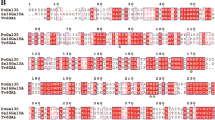Abstract
Mimosa pudica Linn leaves with pulvini contain unique isoforms (I and II) of apyrase enzyme (EC 3.6.1.5). The activity of isoform I depends on divalent cation Mn2+. This isoform is associated noncovalently with the polysaccharide, containing mainly of galactose and arabinose sugars. The apparent molecular mass of these 2 isoforms are 36 and 34 Kd respectively. The association of the polysaccharide with the isoform I has been found to be Ca2+ dependent which is endogenously present in this isoform. Removal of Ca2+ and polysaccharide from the enzyme (isoform I) leads to an inactivation. The enzyme activity can be restored when both Ca2+ and endogenous polysaccharide fraction were added at an optimal molar ratio of Ca2+:protein of 7:1. The endogenous polysaccharide can be replaced by the standard arabinogalactan. No other sugar or polysaccharide except the arabinogalactan can restore the apyrase activity. Calcium mediates a conformational change in the protein which helps in association of polysaccharide as evidenced from fluorometric and far UV-CD studies to restore the enzymic activity. Neither any interaction of the polysaccharide with the protein is detected in absence of Ca2+ nor the enzyme activity could be recovered under such condition.
Similar content being viewed by others
References
Lyubimova MN, Demianovskaya NC, Fedorovich IB, Itomlenskyte IV: The part played by ATP in the motor function of the Mimosa pudica leaf (in Russian). Biokhymya 29: 774-779, 1964
Kuo CF, Lou CH: Histochemical observations on the distribution of adenosine triphosphatase in phloem and motor organs in higher plants. Acta Botanica Sinica 14: 45-49, 1966
Biswas S, Bose DM: An ATPase in sensitive plant Mimosa pudica: Purification and characterization. Arch Biochem Biophys 148: 199-207, 1972
Toriyama H, Jaffe MJ: Migration of calcium and its role in the regulation of seismonasty, in the motor cells of Mimosa pudica. Plant Physiol 49: 72-81, 1972
Roblin G: Experimental analysis of seismonastic movement in the sensitive plant. Nature 261: 437-438, 1976
Mukherjee J, Biswas S: Purification and characterization of a nucleoside triphosphatase from Mimosa pudica. Indian J Biochem Biophys 17: 452-456, 1980
Isshikawa H, Tamiya T, Tsuchiya T, Matsumoto J: A novel ATP-ADPase from Mimosa pulvinus. Comp Biochem Physiol 78B: 9-61, 1984
Davis BJ: Disc electrophoresis II. Method and applications to human serum proteins. Ann NY Acad Sci 121: 404-427, 1964
Hames BD: Introduction to PAGE. In: B.D. Hames, D. Rickwood (eds). Gel Electrophoresis of Proteins, A Practical Approach. ORL Press, Oxford, Washington DC, USA, 1967, pp 1-91
Laemmli UK: Cleavage of structural proteins during the assembly of the head of bacteriophage T4. Nature 227: 680-685, 1970
Bates RG, Bower VE: Alkaline solutions for pH controls. Anal Chem 28: 1322-1324, 1956
Dubois M, Gills KA, Hamilton JK, Rebers PA, Smith F: Colorimetric method for determination of sugars and related substances. Anal Chem 28: 350-354, 1956
Chen PS, Toribara TY, Warner H: Microdetermination of phosphorous. Anal Chem 28: 1756-1758, 1956
Roy S, Banik U: A continuous fluorimetric assay for ATPase activity. Biochem J 266: 611-614, 1990
Sen PC, Pfeiffer DR: Loss of Na+, K+ ATPase activity during cataract formation. In: Y. Bronnes, A. Kleinzeller (eds). Current Topics in Membrane and Transport, Vol 19. Academic Press, New York, 1983, pp 959-964
Scopes RK: Measurement of protein by spectrophotometry at 205 nm. Anal Biochem 59: 277-282, 1974
Lowry OH, Rosebrough NJ, Farr AL, Randall RJ: Protein measurements with the folin phenol reagent. J Biol Chem 193: 265-275, 1951
Stec WJ, Zon G, Uznaski B: Reversed-phase high performance chromatographic separation of diastereomeric phosphorothioate analogues of oligodeoxyribonucleotides and other backbone modified congeners of DNA. J Chromatogr Sci 326: 263-280, 1985
Lehrer SS: Solute perturbation of protein fluorescence. The quenching of the tryptophyl fluorescence model compounds and of lysozyme by iodide ion. Biochemistry 10: 3254-3263, 1971
Cantor CR, Schimmel PR: Techniques for the study of biological structure and function. Biophys Chem Part 2: 428-432, 1980
Yang JT, Wu CC, Martinez HM: Calculation of protein conformation from CD. Meth Enzymol 130: 208-268, 1986
Kim HC, Paess BU: Verapamil, delteagem and nifedipine interactions with calmodulin stimulated Ca2+, Mg2+-ATPase. Biochem Pharmacol 37: 917-920, 1988
Fincher GB, Stone BA, Clarke AK: Arabino galactanproteins: Structure and function. Ann Rev Plant Physiol 34: 47-70, 1983
Pennel RI, Janniche L, Kjellbom P, Scofield GN, Peart JM, Roberts K: Developmental regulation of plasma membrane arabinogalactan protein epitope in oilseed rape flowers. Plant Cell 3: 1317-1326, 1991
Clarke AK, Anderson RI, Stone BA: Form and function of arabinogalactans and arabinogalactan proteins. Phytochemistry 18: 521-540, 1979
Sistrunk ML, Autosiewicz DM, Purugganan MM, Braan J: Arabidopsis TCH3 encodes a novel Ca2+ binding protein and shows environmentally induced and tissue specific regulation. Plant Cell 6: 1553-1565, 1994
Penel C, Greppin H: Binding of plant isoperoxidases to pectin in presence of calcium. FEBS Lett 343: 51-55, 1994
Kiefer S, Penel C, Greppin H: Ca2+ and Mn2+ mediated binding of the glycoprotein peroxidase to membranes of pharbitis cotyledons. Plant Sci 39: 37-43, 1985
Author information
Authors and Affiliations
Rights and permissions
About this article
Cite this article
Ghosh, R., Sen, P.C. & Biswas, S. Mimosa pudica apyrase requires polysaccharide and Ca2+ for the activity. Mol Cell Biochem 187, 47–55 (1998). https://doi.org/10.1023/A:1006855627784
Issue Date:
DOI: https://doi.org/10.1023/A:1006855627784




